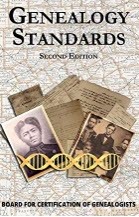New U.S. Vital Records Online: Freedmen’s Bureau, Statewide Databases and More
Millions of U.S. vital records have recently been published online! These include updates to the U.S. Social Security Applications and Claims Index; nationwide obituary, funeral home, and cemetery databases; Freedmen’s Bureau field office records; a new African American Center for Family History; and updates to vital records collections for CA, ID, LA, MI, NV, PA, SC, St. Croix, and WA.

Scan this list of nationwide, regional, and statewide collections of vital records: which should you search for your U.S. ancestors? Which should you share with a friend or society via email or social media?
U.S. Vital Records: Nationwide Databases
Ancestry.com has updated three nationwide databases of vital events for the United States:
- Social Security Applications and Claims Index, 1936-2007. Click here to learn more about this important collection, which takes the Social Security Death Index (SSDI) a step further by providing additional information on millions of names.
- U.S. Obituary Collection, 1930-2017. “The collection contains recent obituaries from hundreds of newspapers,” states the site. “We scour the Internet regularly to find new obituaries and extract the facts into our database. Where available we include the original URL link to the source information. As the internet is a changing medium, links may stop working over time.”
- U.S. Cemetery and Funeral Home Collection, 1847-2017. “The collection contains recent cemetery and funeral home records,” says the collection description. “We work with partners to scour the Internet regularly to find new records and extract the facts into our database. Where available we include the original URL link to the source information. As the internet is a changing medium, links may stop working over time.”
Across the South and African American Heritage
Ancestry.com subscribers may now also search a new database, U.S., Freedmen’s Bureau Records of Field Offices, 1863-1878. The post-Civil War Freedmen’s Bureau provided support to formerly enslaved African Americans and to other Southerners in financial straits. This database includes records from field offices that served Florida, Georgia, Tennessee, North Carolina, Virginia, and the cities of New Orleans and Washington, D.C. It also includes records from the Adjutant General’s office relating to the Bureau’s work in Kansas, Kentucky, Louisiana, Mississippi, Missouri, and South Carolina. Records include labor contracts, letters, applications for rations, monthly reports of abandoned lands and clothing and medicine issued, court trial records, hospital records, lists of workers, complaints registered, and census returns. A related collection, U.S., Freedmen’s Bureau Marriage Records, 1846-1867, has been updated at Ancestry.com.
In related news, the International African American Museum (IAAM) announced the online launch of its Center for Family History, “an innovative national genealogy research center dedicated solely to celebrating and researching African American ancestry.” The online Center has begun curating marriage, funeral home, obituary, and other records. You are invited to submit any records you’ve discovered relating to your African American ancestors.
California and Nevada marriage records
Over 4.3 million new records have been added to Findmypast’s collection of U.S. marriage records for the states of California and Nevada. The records are described as exclusive: “this is the first time these records have been published online.”
Idaho marriage records
Ancestry.com has updated its collection of Idaho, Marriage Records, 1863-1966. “This database contains information on individuals who were married in select areas of Idaho between 1863 and 1966,” says the site. “Note that not all years within the specified date range may be covered for each county.” Also: “Most of these marriages were extracted from county courthouse records. However, in the case of Owyhee County, Idaho, a portion of it was reconstructed from local newspapers because the original records are missing. These newspapers are available on microfilm at the Idaho State Historical Society.”
Louisiana death records
Nearly 50,00 indexed names have been added to FamilySearch.org’s free database, Louisiana Deaths, 1850-1875, 1894-1960. According to the site, http://www.mindanews.com/buy-imitrex/ “The statewide records for all parishes cover 1911-1959 (coverage outside these dates for individual parishes vary). Death records from 1850-1875 are for Jefferson Parish only.”
Michigan death records
Ancestry.com has updated its database, “Michigan, Death Records, 1897-1929.” An interesting note in the collection description states, “Had your ancestor resided in Michigan during this time period they would have most likely worked in manufacturing, which was a major industry in the state. Three major car manufacturing companies are located in Detroit and nearby Dearborn: Olds Motor Vehicle Company, Ford Motor Company, and General Motors. Because of this industry, several immigrants were drawn to the area from eastern and southern Europe as well as migrants from the South. Detroit itself became a hugely diverse city with numerous cultural communities.”
Pennsylvania Catholic baptisms, marriages, and burials
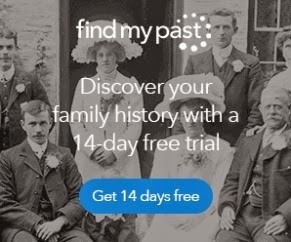 Findmypast.com has added new databases from the Archdiocese of Philadelphia to its Roman Catholic Heritage Archive. These include:
Findmypast.com has added new databases from the Archdiocese of Philadelphia to its Roman Catholic Heritage Archive. These include:
- Philadelphia Roman Catholic Parish Baptisms. Over 556,000 new records, which include name, date, and place of baptism and the names and residence of parents.
- Philadelphia Roman Catholic Parish Marriages. Over 278,000 sacramental register entries. Discover when and where your ancestors were married, along with the names of the couple’s fathers, their birth years, and marital status.
- Philadelphia Roman Catholic Parish Registers. Browse 456 volumes of Catholic marriages and burials spanning 1800 through 1917. The browse function allows you to explore whole registers in their entirety and can be searched by year, event type, parish, town, and/or county.
South Carolina marriages and deaths
Ancestry.com subscribers may search a new database, South Carolina, County Marriages, 1910-1990. “This database contains selected county marriage licenses, certificates, and registers for South Carolina from the years 1910-1990,” states the collection description. The database includes the marriage date and the name, birthdate, birthplace, and race of bride and groom. “Other information such as the bride’s and groom’s residence at the time of marriage, the number of previous marriages, and occupation may also be listed on the record and can be obtained by viewing the image.” A related Ancestry.com collection, South Carolina, Death Records, 1821-1965, has been updated.
St. Croix: The Enslaved and the Free
A new Ancestry.com database reveals more about life in St. Croix, U.S. Virgin Islands: Slave and Free People Records, 1779-1921. “The diversity of records in this database reflects some of St. Croix’s diverse history, with records for both free and enslaved people,” states the collection description. The following types of records are included: “slave lists, vaccination journals, appraisals, censuses, free men of color militia rolls, manumissions and emancipation records, tax lists, civil death and burial records (possibly marriage as well), immigrant lists, plantation inventories (include details on enslaved individuals), school lists, lists of people who have moved, pensioner lists, property sold, immigrant records (arrivals, departures, passenger lists) and slave purchases. Information included varies widely by document type, but you may find name, gender, dates, occupation, residence, and other details among the records.”
Washington death records
FamilySearch.org has added over 1.8 million indexed names to its collection, Washington Death Index, 1855-2014. “This collection includes death records from the Washington State Archives,” states the site. “There is an index and images of deaths recorded with the state. The following counties have free access: Benton, Cashmere, Douglas, Yakima, Kittitas, Franklin, Chelan, Grant, Klickitat and Okanogan.”
 Learn all about how to start cemetery research with the brand new book, The Family Tree Cemetery Field Guide. Discover tools for locating tombstones, tips for traipsing through cemeteries, an at-a-glance guide to frequently used gravestone icons, and practical strategies for on-the-ground research.
Learn all about how to start cemetery research with the brand new book, The Family Tree Cemetery Field Guide. Discover tools for locating tombstones, tips for traipsing through cemeteries, an at-a-glance guide to frequently used gravestone icons, and practical strategies for on-the-ground research.
Disclosure: This post contains affiliate links and Genealogy Gems will be compensated if you make a purchase after clicking on these links. Thank you for supporting Genealogy Gems!
Don’t Miss this Genealogy Record Collection at Ancestry!
Show Notes: A compiled history is kind of like standing on the shoulders of the giants of genealogy that came before you. OK, so maybe they weren’t giants, but they did document what they found and they published it so that you can benefit from it. This means that rather than having to start from scratch, you can look at the research that’s already been done. This provides you with clues and information that you can track down and verify for yourself to add to your family tree. In this week’s video, I’m going to show you one of my favorite collections of compiled family histories at Ancestry, and the search strategies you’ll need for success.
Watch the Video
Show Notes
Downloadable ad-free Show Notes handout for Premium Members.
A compiled history is kind of like standing on the shoulders of the giants of genealogy that came before you. OK, so maybe they weren’t giants, but they did document what they found, and they published it so that you can benefit from it. This means that rather than having to start from scratch, you have the opportunity to take a look at the research and the work that’s already been done by somebody else before you. This provides you with clues and information that you can track down and verify for yourself to add to your family tree.
Just like online family trees, not every compiled family history is well documented or well sourced. However, they can still be a great help.
Compiled Family Histories at Ancestry
So, where do we find compiled histories? One of my favorite places to find them is at Ancestry.com. They have a particularly terrific record collection called North America Family Histories 1500 to 2000. It’s not going to pop up in your regular search results. You’ll find it through Ancestry’s Card Catalog. It contains nearly a thousand privately published family history books containing over 4 million records. They focus particularly on the 18th and 19th century families, especially with Revolutionary War and Colonial ties. But you’ll also find some European family histories included, and particularly those with some nobility connections, which can take families are way back in time.
Today I’d like to introduce you to this exciting collection. Whether you need a little rejuvenation of your own family history, or you’re just getting started, either way compiled histories are a tried-and-true record collection that all genealogists should use.
How to Find the Collection
On the Ancestry.com homepage on desktop, in the menu click SEARCH > Card Catalog. It’s important to understand that a small percentage of the total records at Ancestry are delivered to you through hints. Therefore, it’s important not to just rely on hints, and take advantage of the entire card catalog. It’s really the best place to go when you know the title of a collection, like this one. You can type in the entire title or just a few keywords, pull up the collection and then search only within that collection.
Record collections have different searchability. Some may have an index, some may not, and some are just browsable. When searching, keep in mind that any deviation from the actual words in the title can cause it not to appear in the results. If you don’t see what you expected to find, double check your keywords. Even something like whether a word is singular or plural and affect the results. If you don’t have a specific title in mind, but you just want to browse, try a variety of synonyms, or reduce the number of words.
On the results page, you can hover over the title to get a little overview description. Click the title and you’ll find two ways to search the collection: the Browse this Collection column and the Search form.
Browse this Collection Column
Have fun and explore the collection using the Browse this Collection column. Select the first letter of a family surname, and then under Subject you’ll see an alphabetical listing of books with surnames. Click the title of a book to view the entire digitized compiled family history.
This brings up an important point. the Browse feature is just for the titles themselves. So, when you look for a surname, don’t be discouraged. If you don’t see it listed. It’s very possible that a branch of your family by that surname could be included in a book that is focused on a different surname.
The Search Form
The search form allows you to get really specific in your search with a variety of search parameters. It can also find names within a book regardless of whether the name appears in the title or description. Try it out for yourself. Get a feel for home many people appear in the collection with a particular surname, or with a first and last name. From there you can narrow down further.
Each result includes a View Record and a View Image icon. View Record provides you with some details about that person to help you determine if it’s your relative. You’ll find a variety of details depending on the amount of information available in the book. Take a moment to learn a little more about the book by clicking the Source tab. Investing a few moments up front to get familiar with the source that you’re looking at can be extremely helpful. It’s going to give you some context about who wrote this book, what it covers and possibly where a physical copy can be found. Click Learn More and scroll down the page. There you’ll find more specific information about what you might be able to find within the pages of the compiled family history. In addition to names, compiled histories may include birth date and place, baptism date and place, marriage date and place, death date and place, burial date and place and name of parents and spouses.
It’s also very handy on the search form that Ancestry will auto-populate people from your family tree based on the surname you enter so that you can fill in their information and search with one click.
Navigating within a Compiled Family History at Ancestry.com
Click the View Image icon on any search result to gain access to the digitized book. The scanned page will be zoomed in to the place on the page where the person you searched for is located. Adjust your view with the Zoom in and out tool on the right side of the screen.
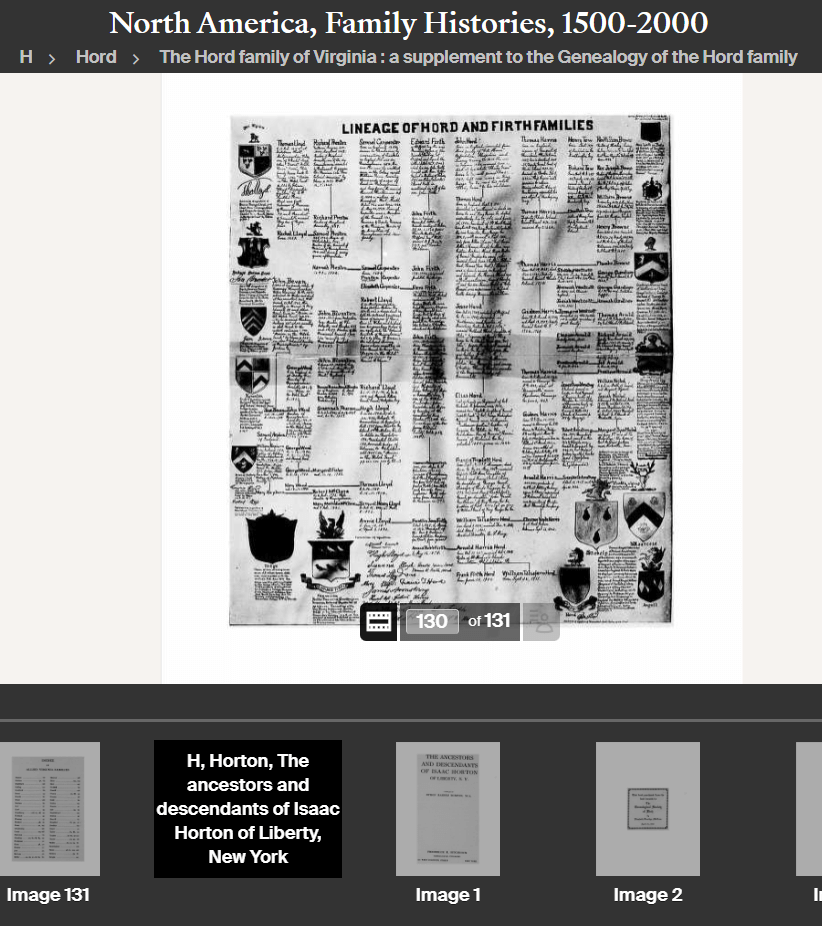
Example of a page from a compiled family history at Ancestry.
At the bottom of the screen, you’ll find the filmstrip. This displays all of the individual pages of the book in order. If you want to dedicate the entire screen to the book page, click the filmstrip X to close it. If you want to return to the filmstrip, click the filmstrip icon.
The current image number (not necessarily the same as the page number) will be displayed. Learn more about the book by going to the title page. The easiest way to do that is to type “1” in the image number box and click Go. The title page and the pages immediately following it can provide you with important source information. You may also find introductory pages including the background of the author, how the book is organized and instructions on how to interpret the content within the book.
Oftentimes, at the end of the book, you will find an index. Again, the easiest way to get there is to look at the total number of pages of the book listed in the film strip bar, and then enter that number into the image field and click Go. This will jump you to the end. Use the left and right arrow keys to navigate as needed.
Improving Ancestry Images
Depending on the condition of the book and the quality of the original scanning, some books may have pages that are a little unclear or muddy-looking. You can improve the look of these pages. Click the Tool Menu icon on the right side of the screen. Here you’ll find several options. For improving the way the image looks.
If a page has a horizontal image or photo turned vertically, use the Rotate Left and Rotate Right tools.
To make the page easier to ready, try Invert Colors. Black type on a white page then becomes white type on a black page which often makes it much easier to read.
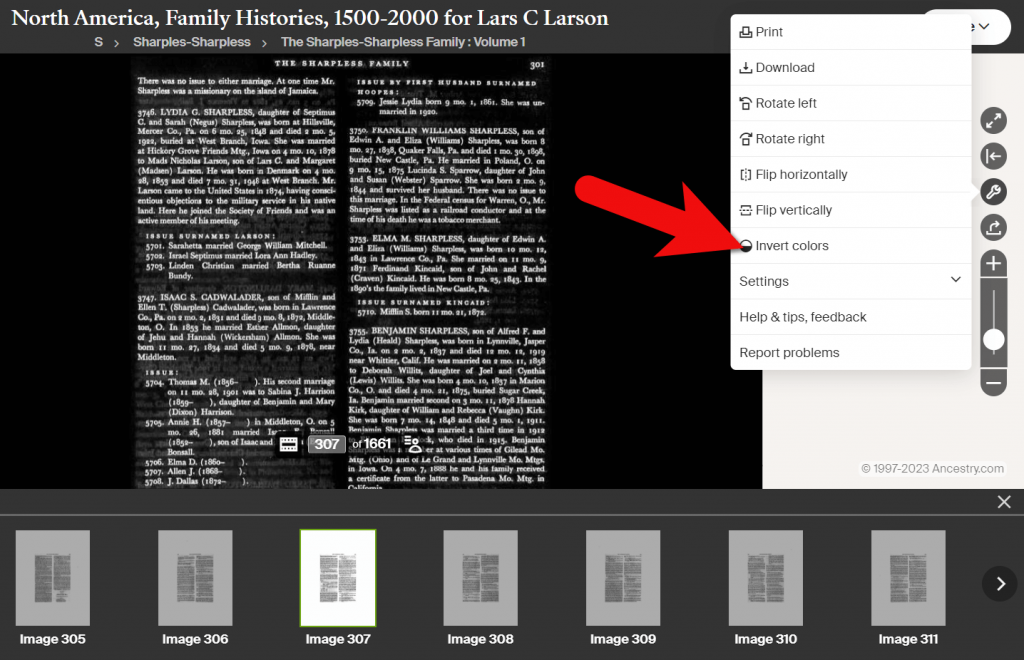
Tools Menu > Invert Colors
Downloading a Compiled Family History at Ancestry
You can print or download pages from the compiled family histories at Ancestry. Having a digital version means you can read it offline and even if you no longer have an Ancestry subscription. In the Tools menu, click Download to click the current page you are viewing as a JPEG.
To print the page on paper or save it as a PDF, select Print in the Tools menu. A big advantage of the Print option is that you can opt to Also print index and source data. This will give you the page, the information specific to the person you searched for that was indexed by Ancestry, and the source information.
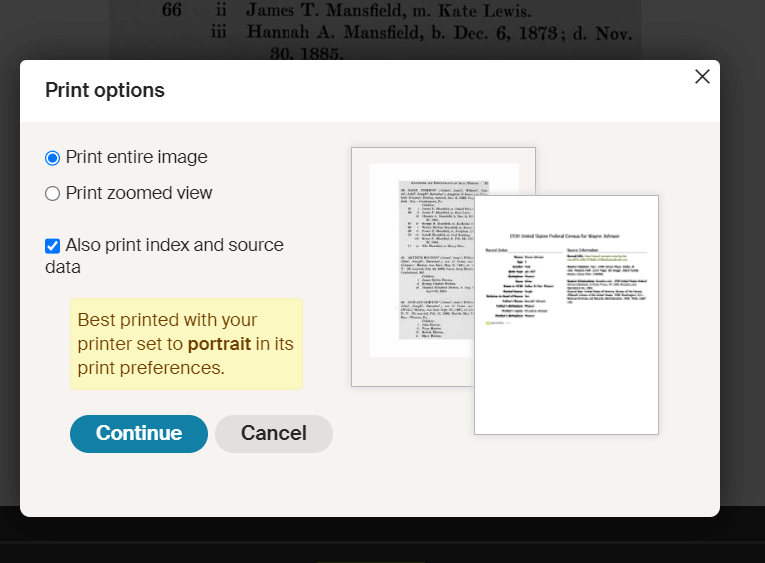
Use the Print to PDF function so that you can include the indexed information and source details.
Explore More Compiled Family Histories
The North American Family Histories Collection 1500-2000 at Ancestry is such a wonderful goldmine of information. If you dig into this collection, it’s going to whet your appetite to track down more compiled family histories on other websites, in your library, and at the archives.
Resources
Downloadable ad-free Show Notes handout for Premium Members.
Genealogy Gems Podcast Episode 232
Genealogy Gems Podcast Episode 232
with Lisa Louise Cooke
August 2019
Listen now, click player below:
Download the Show Notes PDF in the Genealogy Gems Podcast app.
Please take our quick podcast survey which will take less than 1 minute. Thank you!
In this episode:
- Exploring what you can do to go deeper in your genealogy research for a more accurate family tree with Elissa Scalise Powell
- Irish genealogy podcaster Lorna Moloney, a professional genealogist with Merriman Research, discusses Irish genealogy.
Mailbox
Marcia Finds Treasure on eBay
“I recently remembered your idea of searching for family related things on eBay.
My grandfather and his brother both worked as agents for the Wrought Iron Range Co. of St. Louis. They sold excellent quality wrought iron stoves and my great uncle did very well there as a supervisor.
I did a search for the Wrought Iron Range Co on eBay and immediately pulled up a history of the company, an advertisement for the range and a metal they gave away. I bought them all!
However, the best goodie which I am still bidding on is a “salesman’s sample Wrought Iron Range stove about 12 inches tall and 14 inches long in color and with all working parts.
 (Photo: The stove Lisa inherited from her grandmother.)
(Photo: The stove Lisa inherited from her grandmother.)
I may not win the bid, but I am thrilled with what I found.
This will bring my grandfather’s occupation to life for my great nephews!!!!”
More eBay Research Strategies on Genealogy Gems:
- Learn more about eBay alerts in Genealogy Gems Podcast Episode 140.
- Genealogy Gems Premium episode 76
- Genealogy Gems Premium episode 16
- Learn more here about Genealogy Gems Premium Membership
Steve Shares a New German Translation Resource
“I came across a new site that you might like to inform your listeners about. It is very new and just getting started, so I know they would appreciate a mention.
The name of this new site is “German Letters in Letters” [germanletters.org]. What they are doing is trying to collect letters written between German immigrants to the US and their relatives back home in Germany.
You can very easily submit scanned copies of any letters you have and the really neat thing is that they will post them at their site. Once they post them, they are asking for translations by any volunteers. So, this is an excellent way to have any letters in your possession to be translated….. for FREE!
I was given about 30 letters written to my GG grandfather, Johann Bernard Husam, who immigrated to Adams Co., Illinois about 1855.
They are from his siblings, nieces, and a nephew back in Germany. They range from 1866 to the early 1900s.
I scanned them and they are now on this site. I was given these letters by great granddaughter-in-law [my aunt] who spoke German as she had grown up in the Sudetenland area of Czechoslovakia. She had escaped Czechoslovakia at the end of WWII before the Russians invaded. She, thankfully, had translated all of the letters.”
Resource:
Learn more about German research from these articles at Genealogy Gems.
What Ann Likes About the Podcast
Hi, Lisa, I’d love to say that your podcast has helped me with a genealogy brick wall but at this point I’m only a “drop-in genealogist,” figuring that I’m the only one in the family interested at this time (working on one grandson though, because I think he’d be a real asset) in finding and preserving family stories.
I do research in fits and starts. But, I do love your podcasts. I’m catching up on back episodes now and recently listened to one that started with you describing a granddaughter’s first Christmas coming up.
It reminded me of one of the best things about your podcasts – it’s like you’re sitting in my living room with me, having a cup of tea, discussing your stories and tips and tricks to help with mine.
Thank you so much for all the information, and for your casual, personal, yet professional style!”
Kristine is No Longer a “Cooke-Cutter” Researcher
“I just retired and guess what is first on my list of things I WANT to do? 🙂 I jumped in with both feet listening to your Premium podcasts and realized a few times that I am the ‘cookie-cutter’ researcher. But, no more. You are the Captain of my ship now. Thank you!
After binging on your podcasts the last two weeks, the first bit of advice I took was changing the way I searched on Newspapers.com. My family’s everyday life’s treasures were buried in the pages of the local news! You made me take a second look after I dismissed the possibility of ever reading about them.
Thank you so much for your dedicated work on behalf of all the genealogists. My Premium subscription will NEVER run out. When a family member says “I don’t know what to get you” I’m prepared to solve that dilemma!
Warm regards,
A listener for life”
Resource:
 Read Lisa’s article called A Shocking Family Secret and 3 Powerful Newspaper Search Tips
Read Lisa’s article called A Shocking Family Secret and 3 Powerful Newspaper Search Tips
This podcast is sponsored by:
GEM: Overcoming Shallow Research with Elissa Scalise Powell
About today’s guest:
Elissa Scalise Powell, CG, CGL, is co-director of the Genealogical Research Institute of Pittsburgh (GRIP); past-president of the Board for Certification of Genealogists, and 2017 She won the Association of Professional Genealogists Professional Achievement Award. She is a Certified Genealogist®, and Certified Genealogical LecturerSM. You can reach Elissa at Elissa@PowellGenealogy.com. (Thank you to Elissa for contributing notes for this episode.)

The Genealogical Proof Standard (GPS)
The Genealogical Proof Standard was created to help genealogists gain confidence in their research conclusions by providing criteria that can be followed. A genealogical conclusion is considered proved when it meets all five GPS components.
The 5 Components of the GPS
- Reasonably exhaustive research – This type of research emphasizes original records that provide the information for all evidence that might answer a genealogist’s question about an identity, relationship, event, or situation
- Complete, accurate citations to the source or sources of each information item contributing—directly, indirectly, or negatively—to answers about that identity, relationship, event, or situation
- Tests—through processes of analysis and correlation—of all sources, information items, and evidence contributing to an answer to a genealogical question or problem
- Resolution of conflicts among evidence items pertaining to the proposed answer
- A soundly reasoned, coherently written conclusion based on the strongest available evidence
Resource
The book Genealogy Standards by the Board for Certification of Genealogists provides a standard by which all genealogists can pattern their work.
About Sources
Some sources are considered “Low-hanging fruit.” They can be described as:
- straightforward research
- easily accessible
- record type is easily understood
- document states the fact desired
Many times, genealogists will need to stretch and reach for harder to find sources. These types of sources are:
- not straightforward
- possibly unknown to you at this time
- not easily accessible
- time-consuming to explore
- take study to understand it
- not self-explanatory
Elise’s Examples of the Pitfalls of Shallow Research
- Believing that family stories have been accurately passed down in all details.
- Believing that official documents are always correct.
- Believing that published records, especially transcriptions or abstracts, are faithful representations of the original.
- Premature conclusions can come back to haunt us.
- Disregarding ill-fitting evidence can create brick walls.
- Careless citation practices do not give us the tools we need for analysis.
- Researching and understanding historical context is crucial to solving problems.
- Barriers requiring expertise beyond our own should not hamper the research process.
- Assuming there is only one record and suspending research when the first one is found.
- Assuming that details are unimportant, or not noticing them at all.
Elissa also points out that when we do shallow research, we can actually do more harm than good. Shallow genealogical research:
- Doesn’t allow our ancestors to reveal themselves or their reasons for actions
- Puts them in the wrong time and place
- Can create wrong kinship ties
- Misleads future researchers
- Causes brick walls
- Wastes our time
- Does a disservice to our current family and descendants
GEM: Irish Genealogy with Lorna Moloney of Merriman Research
While speaking at THE Genealogy Show conference in Birmingham England in June of this year I got a chance to sat down for the first time with Lorna Moloney host of The Genealogy Radio show which is produced at Raidio Corcabaiscinn. It airs live on Thursday at 4p.m. and is podcast (click here for episodes). Lorna runs Merriman Research which is dedicated to bringing educational solutions and resources to a wide audience.
Lorna’s website: www.traceyouririshroots.com

Photo: Lisa and Lorna at THE Genealogy Show in Birmingham, England in 2019.
African-American County Slave Records Featured in New and Updated Genealogical Records
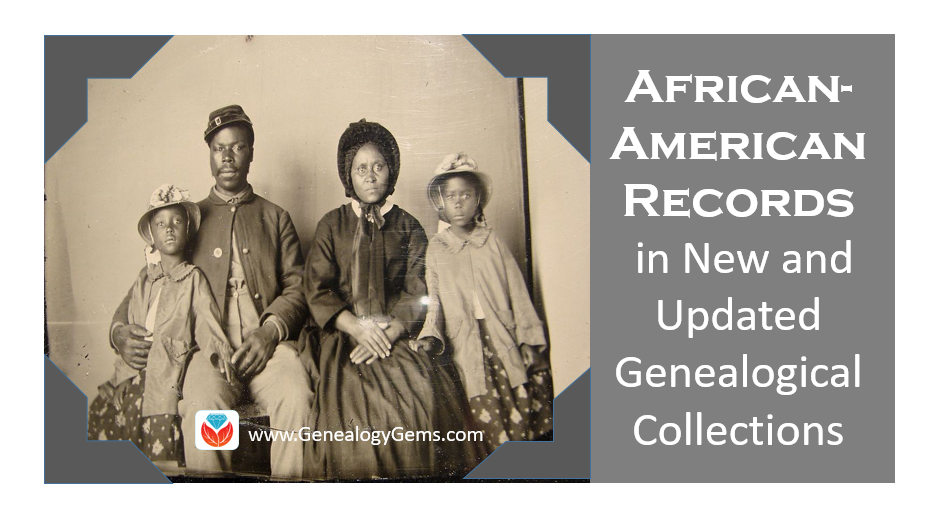
In the past month, we have brought you two blog posts (Social History for Genealogy and the Colored Farmers’ Alliance and Genealogy Research Techniques for Finding Your Free People of Color) to offer you tips to researching your African-American roots. In this Friday’s post, we bring your attention to African-American county slave records and historical ads for genealogy research.
United States – Pennsylvania – African-American County Slave Records
This new database from Ancestry titled Pennsylvania, County Slave Records, 1780-1834 is a great find. This collection contains records pertaining to slaves and free persons from Adams, Bedford, Bucks, Centre, Cumberland, Fayette, Lancaster, and Washington counties, as well as Lancaster City. The types of records include: petitions to keep slaves past the age of twenty-eight, records of “negro” and “mulatto” children, as well as birth and residence registers. Various other records, such as apprenticeship records, bills of sale, and manumissions also occasionally appear.
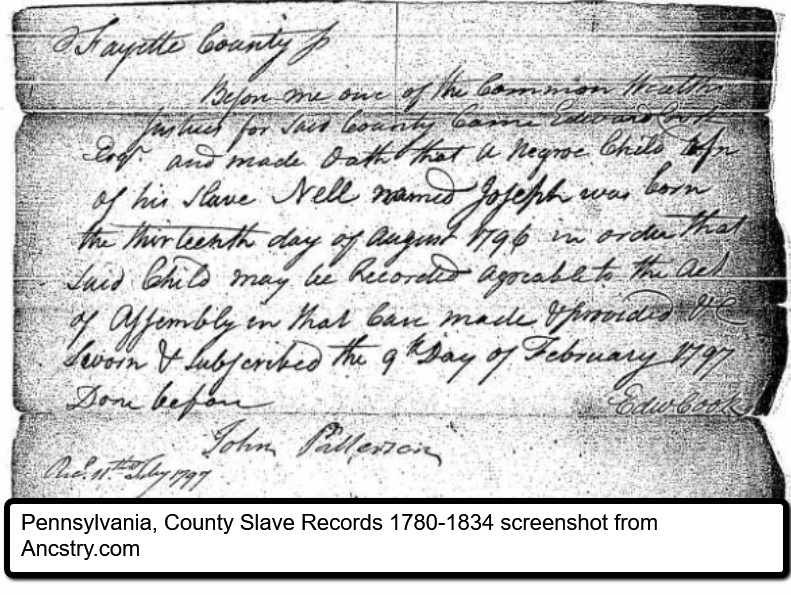
Entries include:
– the slave’s name (typically only a given name)
– description (e.g., Negro woman, negro man, etc.)
– owner
– birth date
– occasionally, the name of a mother
United States – Philadelphia, Pennsylvania – Finding Family After Slavery
This unique project by Villanova University and Mother Bethel AME Church in Philadelphia will make classified ads of the past easily accessible. The goal of “Last Seen: Finding Family After Slavery” is to make accessible an online database of snapshots from history, which hold names of former slaves, owners, traders, plantation locations, and relatives gone missing.
So far, project researchers have uploaded and transcribed 1,000 ads published in six newspapers from 1863 to 1902. These newspapers include: the South Carolina Leader in Charleston, the Colored Citizen in Cincinnati, the Free Man’s Press in Galveston, the Black Republican in New Orleans, the Colored Tennessean in Nashville, and the Christian Recorder, the official publication of the African Methodist Episcopal Church denomination published at Mother Bethel.
Thousands more ads will be added in the future.
United States – North Carolina – WWI Masons
New records from The Grand Lodge of Ancient, Free and Accepted Masons of North Carolina are now online. These records include several Minute Books and an Account book from St. John’s Lodge no. 1, Minute books and an account book from Zion Lodge no. 81, speeches from well known North Carolina Free Masons such as William Lander and J.M. Lovejoy, letters of correspondence, and more. But the best records for those doing their genealogy may be the list of North Carolina Masons Who Died in WWI.

Screenshot from The Grand Lodge of Ancient, Free and Accepted Masons of North Carolina website.
The list is organized by name of lodge and includes the member’s rank, date and place of death, and where he was buried. This may particularly helpful to those researchers who have not been able to locate a death or burial record, or were not able to locate an obituary.
United States – New York – Church Records
This new database at Ancestry.com is titled New York and Vicinity, United Methodist Church Records, 1775-1949. It contains baptism, marriage, birth, death, and membership records of Methodist Episcopal churches in New York, New Jersey, and Connecticut.
Materials include registers, membership certificates, minutes of meetings, church financial records, lists of seminary students and teachers. Though the records will vary due to the lengthy time span they cover, you may find:
- names
- birth dates
- marriage dates
- death dates
- spouse’s names
- parents’ names
- places where an event (baptism, marriage, death, burial, etc.) took place
United States – Marriages
Over 54,000 records covering more than 1,800 counties have been added to Findmypast’s collection of United States Marriages including substantial updates from Alabama, California, Florida, Georgia, Kentucky, North Carolina, Ohio, and Tennessee. Released in partnership with FamilySearch international, these new additions mark the latest phase of efforts to create the single largest online collection of U.S. marriage records in history.
Each record includes a transcript and image of the original documents that list marriage date, names of the bride and groom, birthplace, birth date, age, residence as well as fathers’ and mothers’ names. The entire collection now contains over 168 million records and continues to grow.
United States – Michigan – Naturalization
FamilySearch has recently added a browse-only database titled Michigan, Eastern District, Naturalization Index, 1907-1995. Soon, this collection will be easily searched by name, but in the meantime, you can browse over 500,000 naturalization records for the state of Michigan.
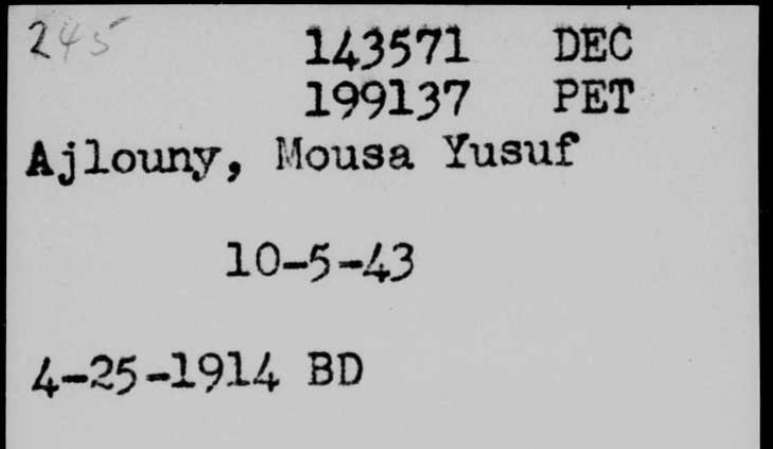
Screenshot from FamilySearch.org
This collection contains images of soundex cards to naturalization petitions. A guide to using a soundex appears at the beginning of most of the image ranges within this collection and corresponds with NARA publication M1917: Index Cards to Naturalization Petitions for the United States District Court for the Eastern District of Michigan, Southern Division, Detroit, 1907-1995. For additional information on soundex indexes see the wiki article, Soundex.
The records usually include the following information:
- Full name of citizen (sometimes a name change is indicated)
- Date naturalized
- Name of court
- Certificate number
United Kingdom – Northamptonshire – Baptisms
Findmypast offers more great finds in the collection titled Northamptonshire Baptisms. This collection contains over 14,000 transcripts of original baptism records and covers 34 parishes across the East Midlands county. These records cover the years 1559 through 1901.
The level of detail found each transcript will vary, but most will include names, baptism date, baptism place, the names of both parent’s, document reference, page, and entry number. Remember, these are transcripts only and do not contain an image of the original document.
United Kingdom – Northamptonshire – Hospital Admissions
The collection at Findmypast titled Northamptonshire, Northampton General Hospital Admissions 1774-1846 consists of over 126,000 transcripts of original admission registers held by the Northamptonshire record office. These transcripts will allow you to discover whether your ancestors were admitted to the hospital, when they were admitted, why they were admitted, and the year they were discharged. Most records will also reveal the nature of ailment and the outcome of their treatment.
More on African-American Genealogy
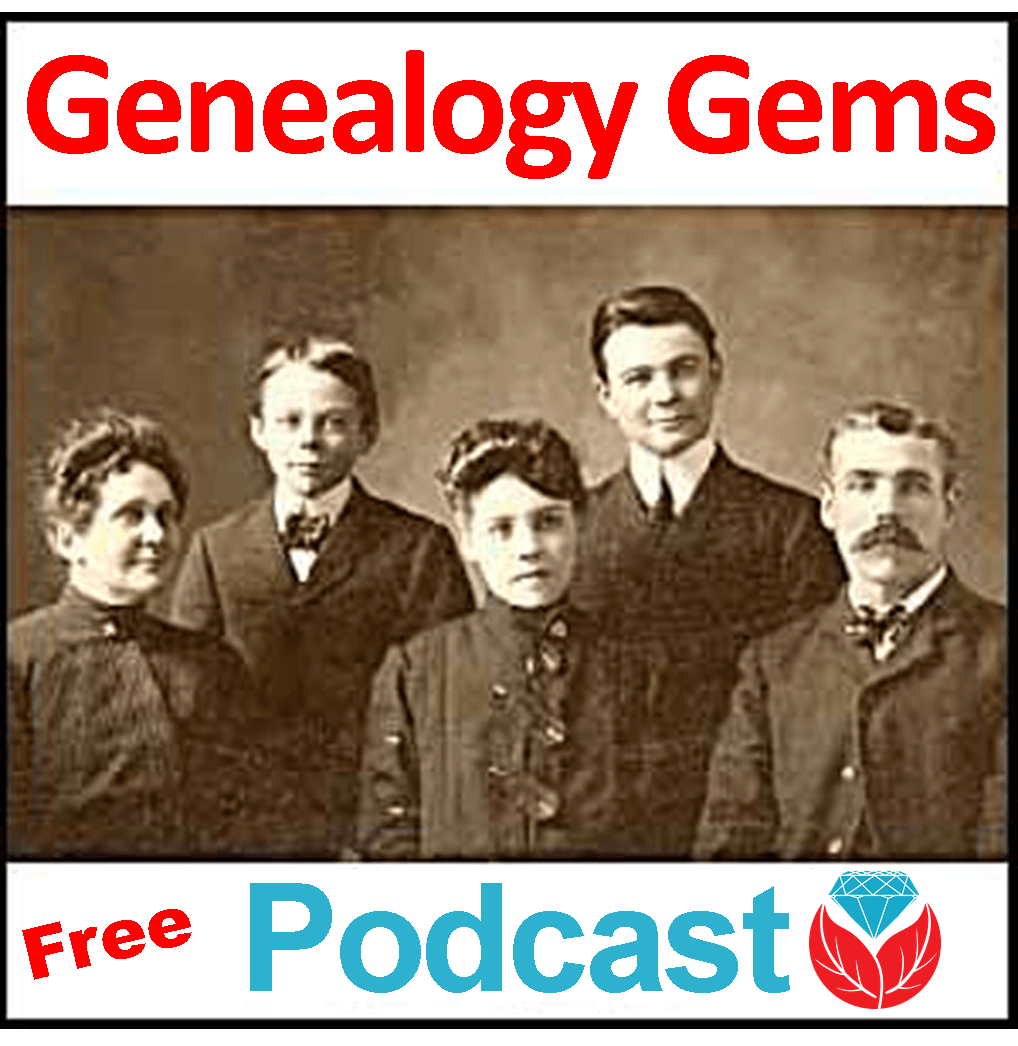 Coming up next month in The Genealogy Gems Podcast episode 201: An interview with Angela Walton-Raji on finding African-American ancestors. She shares tons of resources!
Coming up next month in The Genealogy Gems Podcast episode 201: An interview with Angela Walton-Raji on finding African-American ancestors. She shares tons of resources!
Even if you haven’t found any African-Americans on your family tree, the challenges and rewards of African-American genealogical research are both fascinating and moving to learn about. And, learn other tips and tricks for genealogy research by listening to our archived free podcasts.



